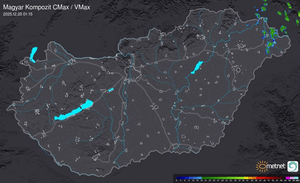Agrometeorológia
émmeg orvos létemre próbálom magyarázni, azt, amit senki sem tanult, és remélem hajlandó valaki - ennek ellenére - figyelni rá,
hogy a globális időjárási trendek megváltozásának antropogén oka van,
éspedig a tengerek élővilágának elszegényedése, a CCN ellátás összetételének (kevesebb szulfát, kevesebb, algák és korallok által termelt DMS, több insolubilis por, amiből aktív CCN sose lesz) változása, a felhőborítottság drasztikus csökkenése, az olajból származó biogén haloalkánok megnövekedett termelése,
kérlek olvassatok bele, beszéljük meg ezeket a cikkeket:
CarstensenJ. et al. (2014) Hypoxia in the Baltic Sea: Biogeochemical Cycles, Benthic Fauna, and Management. AMBIO 43:26–36
Chakraborty R. et al.(2012) Microbial response to the MC-252 oil and Corexit 9500 in the Gulf of Mexico. Front. Microbiol. 2012,(3): 357
CharlsonRJ et al. (1987) Oceanic phytoplankton, atmospheric sulphur, cloud albedo and climate. Nature 326: 655-661
ECDC, EFSA and EMA (2017. jun.28.) second joint report JIACRA. EFSA Journal 2017.15: 4872
Frias-LopezJ. et al.(2002) Partitioning of Bacterial Communities between Seawater and Healthy, Black Band Diseased, and Dead Coral Surfaces. Appl Env microbiol. 68: 2214-2228
Halling-SorensenB. et al. (2002) Toxicity of tetracyclines and tetracycline degradation products to environmentally relevant bacteria, including selected tetracycline-resistant bacteria. ArchEnviron Contam Toxicol. 42:263-71.
Harris SJ. et al. (2012) Antimicrobial Residues and AMR Bacteria: Impact on the Microbial Environ-ment and Risk to Human Health - A Review. Human andEcological Risk Assessment, 18: 767-809
HeuerH. et al.(2011) Antibiotic resistance gene spread due to manure application on agricultural fields. Current Opinion in Microbiology 14:236–243
HoffmannEH. et al.(2016) An advanced modeling study on the impacts and atmospheric implications ofmultiphase dimethyl sulfide chemistry. PNAS113: 11776–11781
HopkinsFE et al. (2016) Air exposure of coralis a significant source of dimethylsulfide (DMS) to the atmosphere. Sci.Rep. 6:36031
Hu,L. et al. ( 2010) Coastal emissions of methyl bromide and methyl chloride along the eastern Gulf of Mexico and the east coast of the United States. Glob. Biogeochem. Cycles 24(1).
IsbisterJ. et al. (1999): Ecological Effects of Antibiotics in Runoff from an Eastern Shore Tributary of the Chesapeake Bay . In:Effects of Confined Animal Feeding Operations (CAFOs) on Hydrologic Resources and the Environment. Fort Collins, Colorado.
Koenig JE. et al.(2011) Succession ofmicrobial consortia in the developing infant gut microbiome. PNAS 108: S1 4578-4585
KolusuSR. et al.(2016) Chloromethane and dichloromethane in the tropical Atlantic Ocean. Atmospheric Environment 150:417-424
KredietCJ et al. (2013) Members of native coral microbiotainhibit glycosidases and thwart colonization of coral mucus by an opportunistic pathogen. The ISME Journal (2013) 7,980–990
Lidburyet al. ( 2016) A mechanism for bacterial transformation of dimethylsulfide to dimethyl-sulfoxide: a missing link in the marine organic sulfur cycle. Env.Microbiol. 18: 2754–2766
LippEK. et al. (2002 ) Preliminary evidence for human fecal contamination in corals of the Florida Keys, USA. MarinePollution Bulletin 44 (2002) 666–670
Marquisj. (2005) Radiative influences on drop and cloud condensation nuclei equilibrium in stratocumulus. J. Geophys.Res. 110, D10205
McCoy DT. et al. (2015) Natural aerosols explain seasonal and spatial patterns of Southern Ocean cloud albedo. Sci. Adv. 2015; 1:e1500157
PandeyPK. et al.(2014) Contamination of water resources by pathogenic bacteria. AMB Express 2014, 4:51
PimentelD. et al.(2005) Environmental, Energetic, and Economic Comparisons of Organic and Conventional Farming
Systems. BioScience 55: 573-582
Rhew,R.C. et al. (2000): Natural methylbromide and methyl chloride emissions from coastal salt marshes. Nature 403 (6767), 292-295
RizzoL. et al. (2013) Urban wastewater treatment plants as hotspots for antibiotic resistant bacteria and genes spread into the environment: A review. Sci Total Env 447: 345–360
Sutherland KP. et al. (2015) Shifting white pox aetiologies affecting Acropora palmata in the Florida Keys,1994–2014. Phil. Trans. R. Soc. B 371: 20150205
Vermeij MJA. et al.(2009) Survival and settlement success of coral planulae Oecologia 159:325–336
Wear SL et al. (2015 ) Sewage pollution: mitigation is key for coralreef stewardship. Ann. N.Y. Acad. Sci 1355 (2015) 15–30
WangJ. et al.(2016) Biodegradation of dispersed Macondo crude oil by indigenous Gulf of Mexico microbial communities. Sci.TotalEnv. 557–558 (2016) 453–468
WMO Scientific Assessment of Ozone Depletion, 2014, Project report No. 55. Geneva, Switzerland.
Young S. et al. (2016, ) Vancomycin-Resistant Enterococci and Bacterial Community Structure following a Sewage Spill into an Aquatic Environment. Appl EnvironMicrobiol 82: 5653–5660
Yokouchi,Y. et al. (2000): A strong source of methyl chloride to the atmosphere from tropical coastal land. Nature 403 (6767),295
Annak is örülnék, ha január 27-én beszélhetnénk róla. Ne mondjátok nekem, hogy csak a teknők és a jégesők fontosak, meg hogy mit ír a GFS... Szeretnék túllépni a GFS-en, és jó lenne, ha találnék Közöttetek valakit, aki segít. Ha hiszünk a médiának, talán időszerű is lenne. Ha kapok 10 percet az előadásokban, ott is megtiszteltetésnek érezném, ha egy vitaindítót elmondhatnék. Már a mikrobiológus konferencián elmondtam Keszthelyen, de ők nem láthatják át rendszerében, az egészet... és jó lenne találni pozitív fogódzót, mi az amit tehetünk, a saját környezetünkben, a saját erőnkből.
Ne várjunk szakértőkre, Ti vagytok azok...
hogy a globális időjárási trendek megváltozásának antropogén oka van,
éspedig a tengerek élővilágának elszegényedése, a CCN ellátás összetételének (kevesebb szulfát, kevesebb, algák és korallok által termelt DMS, több insolubilis por, amiből aktív CCN sose lesz) változása, a felhőborítottság drasztikus csökkenése, az olajból származó biogén haloalkánok megnövekedett termelése,
kérlek olvassatok bele, beszéljük meg ezeket a cikkeket:
CarstensenJ. et al. (2014) Hypoxia in the Baltic Sea: Biogeochemical Cycles, Benthic Fauna, and Management. AMBIO 43:26–36
Chakraborty R. et al.(2012) Microbial response to the MC-252 oil and Corexit 9500 in the Gulf of Mexico. Front. Microbiol. 2012,(3): 357
CharlsonRJ et al. (1987) Oceanic phytoplankton, atmospheric sulphur, cloud albedo and climate. Nature 326: 655-661
ECDC, EFSA and EMA (2017. jun.28.) second joint report JIACRA. EFSA Journal 2017.15: 4872
Frias-LopezJ. et al.(2002) Partitioning of Bacterial Communities between Seawater and Healthy, Black Band Diseased, and Dead Coral Surfaces. Appl Env microbiol. 68: 2214-2228
Halling-SorensenB. et al. (2002) Toxicity of tetracyclines and tetracycline degradation products to environmentally relevant bacteria, including selected tetracycline-resistant bacteria. ArchEnviron Contam Toxicol. 42:263-71.
Harris SJ. et al. (2012) Antimicrobial Residues and AMR Bacteria: Impact on the Microbial Environ-ment and Risk to Human Health - A Review. Human andEcological Risk Assessment, 18: 767-809
HeuerH. et al.(2011) Antibiotic resistance gene spread due to manure application on agricultural fields. Current Opinion in Microbiology 14:236–243
HoffmannEH. et al.(2016) An advanced modeling study on the impacts and atmospheric implications ofmultiphase dimethyl sulfide chemistry. PNAS113: 11776–11781
HopkinsFE et al. (2016) Air exposure of coralis a significant source of dimethylsulfide (DMS) to the atmosphere. Sci.Rep. 6:36031
Hu,L. et al. ( 2010) Coastal emissions of methyl bromide and methyl chloride along the eastern Gulf of Mexico and the east coast of the United States. Glob. Biogeochem. Cycles 24(1).
IsbisterJ. et al. (1999): Ecological Effects of Antibiotics in Runoff from an Eastern Shore Tributary of the Chesapeake Bay . In:Effects of Confined Animal Feeding Operations (CAFOs) on Hydrologic Resources and the Environment. Fort Collins, Colorado.
Koenig JE. et al.(2011) Succession ofmicrobial consortia in the developing infant gut microbiome. PNAS 108: S1 4578-4585
KolusuSR. et al.(2016) Chloromethane and dichloromethane in the tropical Atlantic Ocean. Atmospheric Environment 150:417-424
KredietCJ et al. (2013) Members of native coral microbiotainhibit glycosidases and thwart colonization of coral mucus by an opportunistic pathogen. The ISME Journal (2013) 7,980–990
Lidburyet al. ( 2016) A mechanism for bacterial transformation of dimethylsulfide to dimethyl-sulfoxide: a missing link in the marine organic sulfur cycle. Env.Microbiol. 18: 2754–2766
LippEK. et al. (2002 ) Preliminary evidence for human fecal contamination in corals of the Florida Keys, USA. MarinePollution Bulletin 44 (2002) 666–670
Marquisj. (2005) Radiative influences on drop and cloud condensation nuclei equilibrium in stratocumulus. J. Geophys.Res. 110, D10205
McCoy DT. et al. (2015) Natural aerosols explain seasonal and spatial patterns of Southern Ocean cloud albedo. Sci. Adv. 2015; 1:e1500157
PandeyPK. et al.(2014) Contamination of water resources by pathogenic bacteria. AMB Express 2014, 4:51
PimentelD. et al.(2005) Environmental, Energetic, and Economic Comparisons of Organic and Conventional Farming
Systems. BioScience 55: 573-582
Rhew,R.C. et al. (2000): Natural methylbromide and methyl chloride emissions from coastal salt marshes. Nature 403 (6767), 292-295
RizzoL. et al. (2013) Urban wastewater treatment plants as hotspots for antibiotic resistant bacteria and genes spread into the environment: A review. Sci Total Env 447: 345–360
Sutherland KP. et al. (2015) Shifting white pox aetiologies affecting Acropora palmata in the Florida Keys,1994–2014. Phil. Trans. R. Soc. B 371: 20150205
Vermeij MJA. et al.(2009) Survival and settlement success of coral planulae Oecologia 159:325–336
Wear SL et al. (2015 ) Sewage pollution: mitigation is key for coralreef stewardship. Ann. N.Y. Acad. Sci 1355 (2015) 15–30
WangJ. et al.(2016) Biodegradation of dispersed Macondo crude oil by indigenous Gulf of Mexico microbial communities. Sci.TotalEnv. 557–558 (2016) 453–468
WMO Scientific Assessment of Ozone Depletion, 2014, Project report No. 55. Geneva, Switzerland.
Young S. et al. (2016, ) Vancomycin-Resistant Enterococci and Bacterial Community Structure following a Sewage Spill into an Aquatic Environment. Appl EnvironMicrobiol 82: 5653–5660
Yokouchi,Y. et al. (2000): A strong source of methyl chloride to the atmosphere from tropical coastal land. Nature 403 (6767),295
Annak is örülnék, ha január 27-én beszélhetnénk róla. Ne mondjátok nekem, hogy csak a teknők és a jégesők fontosak, meg hogy mit ír a GFS... Szeretnék túllépni a GFS-en, és jó lenne, ha találnék Közöttetek valakit, aki segít. Ha hiszünk a médiának, talán időszerű is lenne. Ha kapok 10 percet az előadásokban, ott is megtiszteltetésnek érezném, ha egy vitaindítót elmondhatnék. Már a mikrobiológus konferencián elmondtam Keszthelyen, de ők nem láthatják át rendszerében, az egészet... és jó lenne találni pozitív fogódzót, mi az amit tehetünk, a saját környezetünkben, a saját erőnkből.
Ne várjunk szakértőkre, Ti vagytok azok...



